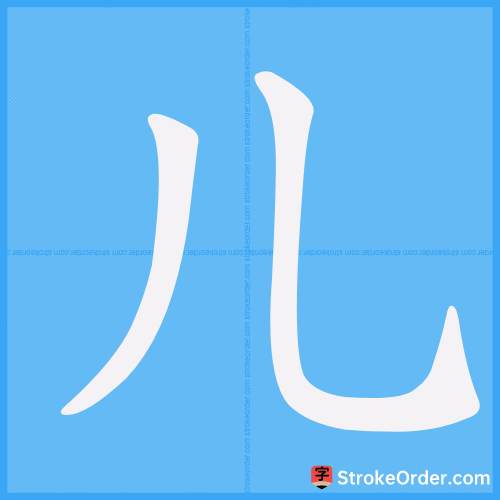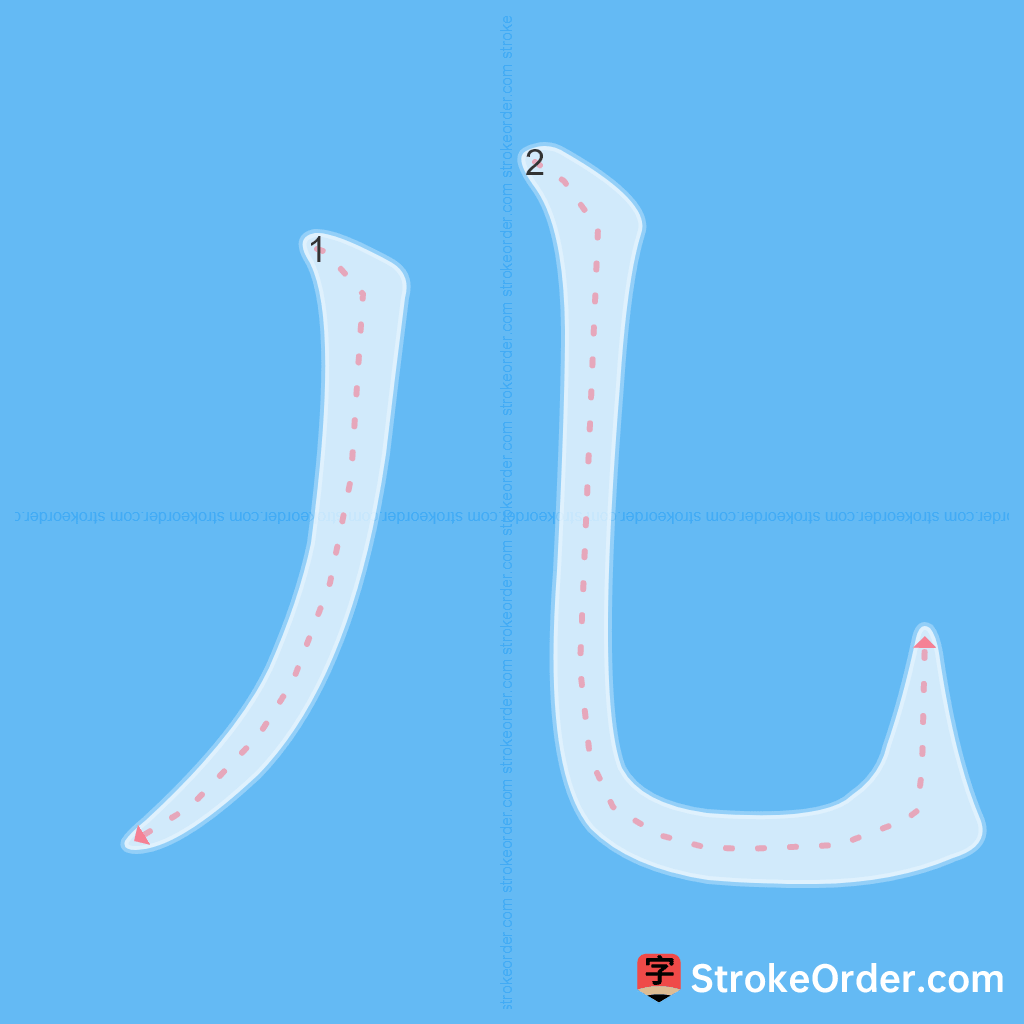儿 Stroke Order
Animated Stroke Order of 儿

Stroke Order Diagrams for 儿

Step-by-Step Handwriting Guide for 儿

Learn to Write Chinese Characters with Video Tutorials
Watch the video of writing the Chinese character "儿", learn the correct stroke order (笔顺) of the character "儿", and master the standard way of writing the character "儿".
Free Printable Handwriting Practice with Stroke Order: 儿
Printable Writing Practice Worksheet of "儿" in Portrait Orientation (Tian Zi Ge)

Printable Writing Practice Worksheet of "儿" in Landscape Orientation (Tian Zi Ge)

Information of 儿
Pinyin
ér、 rén
Radical
儿
Strokes
2 strokes
Usage
★★★★★
Definition
son, non-syllabic dimi. suff.
儿 (ér)
1. 小孩子。
(child)
2. 年轻的人(多指青年男子)。
(young person, often referring to young men)
3. 儿子,男孩子。
(son, boy)
4. 父母对儿女的统称,儿女对父母的自称。
(the collective term for children used by parents, the term children use for their parents)
5. 助詞。
(particle)
6. 小孩子:婴~。~戏。
(child: infant; child’s play)
7. 年轻的人(多指青年男子):男~。~女情。
(young person (often referring to young man): young men; love between young men and women)
8. 儿子,男孩子:~子。生~育女。
(son, boy: son; to give birth to sons and daughters)
9. (used for the collective term for children)
(Note: Indicates the word '儿女' used for children)
10. (used as a suffix for nouns and adjectives)
(The suffix adds small or diminutive connotation, or for creating new forms in verbs and adjectives)
11. (In ancient times, used as a self-reference for young women)
(In ancient times, young females self-referenced)
12. 雄性——多指牲畜。
(male — usually refers to livestock)
13. 自己的,用于古代妇女称自己丈夫。
(one's own, used by ancient women to refer to their husbands)
14. 儿化:汉语后缀的“儿”不自成音节,而和前面一个音节合在一起构成带卷舌韵母r的音节。
(Erhua: The suffix "儿" in Mandarin does not form its own syllable but combines with the preceding syllable to create a syllable with a retroflex vowel r.)
15. 多用作名词后缀:表示小。
(Often used as a noun suffix to denote smallness.)
16. 动词的后缀。
(Suffix used for verbs.)
17. 形容词后缀:如邵雍《首尾吟》:“天听虽高只些子,人情想去没多儿。”
(Adjective suffix: as seen in the works of Shao Yong, the phrase indicates more diminutive reference.)
18. 同【人】。
(Same as [person].)
19. 作助词(同前一字连成一个卷舌音):小孩儿。
(Used as a particle, forming a retroflex sound with the previous character: child.)
This definition captures the multiple meanings and uses of the character "儿," clarifying its role as a term for children and its grammatical functions in Chinese.
karez, qanat or "horizontal well" (irrigation and water management system used in Xinjiang, Central Asia and Middle East)
Input Method for 儿
Pinyin
er2
Wubi
qtn
Cangjie
lu
Zhengma
rd
Four Corner
22010
Unicode
U+513f
Same Pronunciation Characters